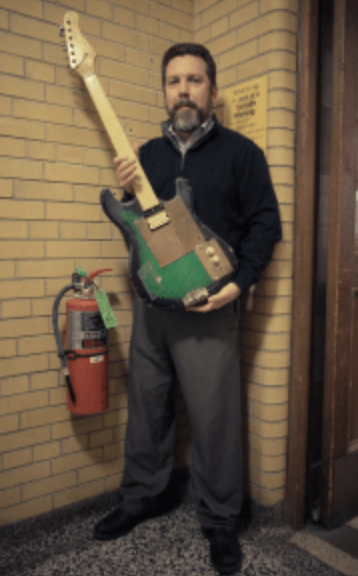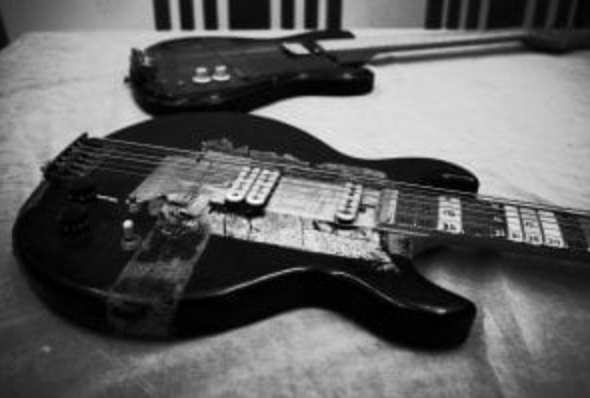Sound, fury, and scholarship
 "Bells are ringing. Loudly. A celestial choir screams in epiphanic ecstasy. The music unrolls like a blistering juggernaut, spiked with ... overtones and textures that conjure voices, horns, violins and cathedral chimes from thin air. Three hundred years earlier Branca would have been hanged for witchcraft." — Ted Drozdowski, Musician Magazine
"Bells are ringing. Loudly. A celestial choir screams in epiphanic ecstasy. The music unrolls like a blistering juggernaut, spiked with ... overtones and textures that conjure voices, horns, violins and cathedral chimes from thin air. Three hundred years earlier Branca would have been hanged for witchcraft." — Ted Drozdowski, Musician Magazine
Glenn Branca hurled noise around like a wrathful god wielding an elemental force. The late avant-garde composer and guitarist was a seminal figure in New York City’s brief but influential No-Wave scene of the 1970s, an experimental art movement that found punk rock too pedestrian. Through music and visual art, No Wave exploded clichés by embracing dissonance, repetition, and an eclectic (read: difficult-to-pin-down) approach that projected the city’s grim underside.
Inspired by earlier minimalists like Steve Reich and Philip Glass, Branca turned to rock ‘n’ roll as a framework for more radical exploration, using rock’s raw power and volume to create epic art — including compositions for up to 100 electric guitars. This could seem dense, brutal, and yet somehow transcendent. (Check out an example of Branca’s tempestuous approach to his own guitar playing.)
Now, a couple of the composer’s modified guitars and a treasure trove of archival materials ranging from scores, photographs, handbills, business documents, test pressings of records to evaluate quality before mass production, and other ephemera have been acquired by Northwestern Libraries.
Over the last two years, Music Library Curator Greg MacAyeal helped bring the Branca archive to Evanston and is especially excited about a thick manuscript that details the composer’s musical theory, including his ideas about using the harmonic series. “It appears to be unpublished and nearly complete,” says MacAyeal. “It’s a great find.”
 Unpublished 1981 Glenn Branca score “for 10 soprano guitars, snare drums, and cymbals,” originally performed by an ensemble that included Sonic Youth’s Thurston Moore and Lee Ranaldo. The score is part of a new archive acquired by Northwestern Libraries. Photo: Matt Golosinski
Unpublished 1981 Glenn Branca score “for 10 soprano guitars, snare drums, and cymbals,” originally performed by an ensemble that included Sonic Youth’s Thurston Moore and Lee Ranaldo. The score is part of a new archive acquired by Northwestern Libraries. Photo: Matt GolosinskiThe materials were moved carefully to Northwestern from Branca’s 5th-floor walk-up in Chelsea where MacAyeal made an initial inventory and visual record with Branca and his spouse prior to the composer’s death in May 2018. Now, the archive is being unboxed, a process that MacAyeal says could take 12 months and will require attention from colleagues on the preservation team, in part because of the items’ fragility. For example, concert fliers for Branca’s groups like Theoretical Girls or Static that would have been posted on billboards or street poles were never intended to last long. His guitars are gritty and deliberately altered — one has odd metal soldering and a block of wood integrated into it — requiring the Libraries team to carefully preserve but also interpret and respect the artist’s intentions. The strings are weathered and likely will be replaced, but only once the Libraries staff verifies what kind they are and how they are supposed to be tuned.
“We’ll keep the old ones, but to make this playable in terms of being an object of study, we may want to restring this,” says MacAyeal.
Once fully processed, the materials will complement and strengthen the University’s already robust holdings in 20th-century music, curated over five decades and including the John Cage and Fritz Reiner collections. MacAyeal himself is already drawing upon the new archives for his current research project, “Resultant Masses: John Cage, Glenn Branca, and the 1982 New Music America Festival.” At this event, Branca performed a 31-minute work for massed guitars.
‘What fascism would sound like’
 Glenn Branca modified guitar. Photo: Matt Golosinski
Glenn Branca modified guitar. Photo: Matt GolosinskiHugely influential for a generation of artists and musicians including Sonic Youth and Swans, Branca fused reinvented rock idioms with 20th-century classical forms. His symphonies and other works employ unusual tunings, homemade instruments, and the composer’s own theories of harmonics, as well as his unbridled passion for music. Acerbic and uncompromising, Branca looked out at a fallen world that disappointed him, and yet he continued to pursue his art. “We’re a bunch of cave men,” he once said. “We’re vicious, psychopathological beasts. And the only reason I even bother to pay the slightest attention to this [expletive] world is because I love music.”
Branca is an acquired taste for many — even those supposedly attuned to the unexpected. Cage, after hearing Branca at the 1982 festival, proclaimed the results “what fascism would sound like.” MacAyeal, a fan of both composers, contends that Cage misunderstood his younger counterpart.
Part of MacAyeal’s preliminary research thesis is that Cage had become an outsider to the very scene that he had mentored earlier in his career. “He had been thought of as the father of modernism since World War II,” says MacAyeal, a 2018-19 Kaplan Institute Fellow. “By the time he encountered Branca, Cage was not really aware of what was going on in new music. I’m still researching this line of thought, looking at Cage’s place in new music circles.”
If Cage — who famously said “there is no noise, only sounds” — was put off by Branca’s jagged, brutalist approach, others have found something exceptional and inspiring in works such as “Light Field (In Consonance)” from Branca’s 1981 album “The Ascension.” Works for electric guitar, including “Lesson No. 1,” use minimalism and repetition to conjure dense overtones and melodies that slowly build and shift.
MacAyeal believes Branca’s creative output deserves and will benefit from more varieties of scholarship to really understand it. He says the composer strived to take his music out of the rock scene and move into a more classical, avant-garde direction in the way that Cage had done decades earlier. “Branca might be one of the first important composers to really distill and elevate aspects of rock music and put it into an art-music venue,” he says. “He’s transforming something, he’s ascending something,” not just burning down everything that came before.
MacAyeal hopes the new archive will introduce more people to an important yet still underappreciated — and under-researched — artist. None of Branca’s music is published, he says, and the archive contains a lot of primary sources about his life and career. It should also prove valuable for those studying the No Wave scene or the Downtown art scene. MacAyeal sees Branca as a figure with a “foot in both circles: one kind of anti-art and the other kind of high-art.” The new collection should help showcase relationships among artists and performers, document the history of specific works, and reveal novel insights about new music as it was being created between in the 1980s and into the early new century.
It’s too soon to say exactly how the archive might otherwise manifest itself, but MacAyeal muses about its potential to eventually become part of a digital humanities project, where the Branca guitars are acoustically modeled using the harmonic series that the composer created, and then people are invited to use these virtual instruments to create new music. It’s also possible that a kick-off event to celebrate the archive being fully processed could involve a public performance of Branca’s work in conjunction with various University partners.
“I would like Branca to be understood as more than just a footnote to Sonic Youth, Thurston Moore, and the rest of that downtown New York scene, because all of that post-rock noise comes from Branca,” says MacAyeal.
By Matt Golosinski